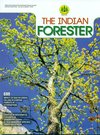Vegetative Propagation and Liquid Chromatography Mass Spectrometry (LCMS) Analysis of Indian Traditional and Endangered Plant Ulmus wallichiana using Air Layering Technology
DOI:
https://doi.org/10.36808/if/2018/v144i8/132337Keywords:
Vegetative Propagation, Air-Layering, Endangered Plant, Ulmus wallichiana, LCMS.Abstract
Ulmus wallichiana is an endangered plant used for healing fractures in folk tradition of Uttarakhand Himalayas, India. Four bioactive metabolites for osteogenic activity have been isolated from the bark of this plant. Habitat degradation, biotic interferences and indiscriminate collection shows decline in species richness and total tree density in Indian Himalayas. This paper reports a fast and effective protocol for vegetative propagation of this plant using stem cuttings and air layering technologies along with Liquid Chromatography Mass Spectrometry (LCMS) analysis of developed plants. Different sizes of coppice shoots and hormonal concentrations i.e. Indole 3-acetic acid (IAA), Indole 3-butyric acid (IBA) and 2, 4 dichlorophenoxy acetic acid (2, 4-D) were used for standardization of optimal conditions for vegetative propagation. 3000 ppm IAA under 65-95% RH and 25-41°C temperature resulted in optimal number of 21.2 sprouts per explants and 6 % rooting through stem cuttings. However, 100 % rooting with an optimal number of 20.7 sprouts was achieved through air layering and it proved to be a better and more efficient technology. The developed plants have been successfully established and acclimatized in tropical environment Moreover, LCMS analysis of leaves from acclimatized plants showed higher peak abundance of quercetin-3-O-alpha-L- rhamnopyranoside, an important metabolite for osteogenic activity.References
Arya K.R. and Agarwal S.C. (2008). Folk therapy for eczema, bone fracture, boils, sores and gingivitis in Taragtal province of Uttaranchal. Indian J TraditKnow, 7:443-445.
Arya K.R., Sharma D. and Kumar B. (2011).Validation and quality determination of an ethno botanical lead for osteogenic activity isolated from Ulmus wallichiana Planch: A traditional plant for healing fractured bones. J. Sci. Ind. Res., 70:360-364.
Bhatnagar H.P. and Joshi D.N. (1977). Rooting response of branch cuttings of teak (Tectona grandis L.). Indian J. Fo.r, 1:7983.
Blakesley D., Weston G.D. and Hall J.F. (1991). The role of endogenous auxin in root initiation. Plant Growth Regul., 10:341353.
Brennan E.B. and Mudge K.W. (1998). Vegetative propagation of Inga feuillei from shoot cuttings and air layering. New Forest, 15(1 ):37-51.
Lai P., Kulkarni H.D. and Srinivas K. (1993). Eucalyptus improvement programme of ITC Bhadrachalan paperboards Ltd. In: Proceedings of workshop on production of genetically improved planting materials for afforestation programmes (Vivekanandhan (eds). 57-63 pp.
Maurya R., Rawat P., Sharan K., Siddiqui J.A., Swamkar G., Manickavasagama L., Arya K.R. and Chattopadhyay N. (2009). Novel flavonol compounds, a bioactive extract/fraction from Ulmus wallichiana and its compound for prevention for treatment of Osteo-health disorders. US Patent 110003.
Maurya R., Yadav D.K., Singh G., Bhargavan B., Murthy P.S.N., Sahai M. and Singh M.M. (2009).Osteogenic activity of constituents from Butea monosperma. Bioorg. Med. Chem. Lett., 19:610-613.
Nanda K.K. (1975).Physiology of adventitious root formation. Indian J. Plant Physiol., 12:99-107.
Nanda K.K., Purohit A.A., Bala A. and Anand V.K. (1968). Seasonal rooting response of stem cuttings of some forest tree species to auxins. Indian Forester, 94:154-182.
Nautiyal S., Singh U. and Gurumurti K. (1991). Rooting response of branch cuttings of Teak (Tectona grandis) as influenced by season and growth hormones and position of cutting on the crown. Indian Forester, 118(2):112-121.
Palanisamy K. and Subramanian K. (2000). Vegetative propagation of mature Teak Trees Tectona grandis L. Silvae. Gen., 50:188-191.
Palanisamy K., Ansari S.A. and MandaA.K. (1995). Standardization of vegetative propagation technology of teak, sissoo, neem, karanj and bamboos. In: Proceedings of UNDP International Workshop on Forestry Research Methods. Indian Council of Forestry Research & Education, Dehradun, 22- 23 pp.
Ranawana S. and Eeswara J.P. (2008). Effects of type and size of stem cutting or propagation media for rapid multiplication of Pineapple (Anana scomosus). Trop. Agric. Res., 10:388-394.
Rawat R, Kumar M., Sharan K., Chattopadhyay N. and Maurya R. (2009). Ulmoside A and B: Flavonoid 6-C- glycosides from Ulmus wallichiana, stimulating osteoblast differentiation assessed by alkaline phosphatase. Bioorg. Med. Chem. Lett., 19:46844687.
Dhillon R.S., Ahlawat K.S. and Pundeer J.S. (2008). Botany of neem. In: Neem-a Treatise I.K. Ltd. International Publishing House Pvt. Ltd. New Delhi, India, pp 30-43.
Duran Casus S., VelozoaSuan C., Magnitskiy S. and Lancheros H.O. (2013). Evaluation of Uva camarona (Macleania rupestris Kunth A.C. Smith) propagation with air layering. Agronomia Colombiana, 31:18-26.
Gurumurti K., Gupta B.B. and Kumar A. (1985). Hormonal regulation of root formation. In: Hormonal Regulation of Plant Growth and Development. Springer Netherlands, (Eds.), 387-400 pp.http://spectra.psc.riken.jp./menta.cgi/respect/datail/datail?accessi on=PS116803. http://www.wipo.int./pctdb/en/wo.jsp?WO=20009110003. IUCN Red list of threatened species (http://www.iucnredlist.Org/details/30410/0).
Samant S.S., Dhar U. and Pilani L.M.S. (1998). Medicinal Plants of Indian Himalaya. In: Diversity Distribution Potential Values. GB Pant Institute of Himalayan Environment and Development, Almora, India.
Summerfield R.J., Huxley PA. and Minchin F.R. (1977). Plant husbandry and management techniques for growing grain legumes under simulated tropical conditions in controlled environments. Exp. Agric., 13:81-92.
Swamkar G. and Sharan K. (2011). A novel flavonoid isolated from the steam-bark of Ulmus wallichiana Planchon stimulated osteoblast function and inhibits osteoclast and adipocyte differentiation. Eur. J. Pharmacol., 658:65-73.
Sweet GB. (1973). Effect of maturation on the growth and form of vegetative propagules of radiata pine. NZ. J. For, 3:191-210.
Thulin I.J. and Flauds T. (1968). The use of cuttings in the breeding and afforestation of Pinus radiate. NZ. J. For., 13:66-77.
Kumari T., Sharma C. and Bajpai V. (2014). Qualitative determination of bioactive metabolites through Q-TOF LC/MS in different parts and undifferentiated cultures of Ulmus wallichiana Planchon. Plant Growth Regul., 75:331-340.
Zobel B. and Ikemori Y.K. (1983). Vegetative propagation in Eucalyptus. In: Clonal Forestry: Its impact on tree improvement and our future Forests (eds) Proc 19th Meet Can Tree Improv Assoc, pt 2, Toronto. 136-144 pp.
Downloads
Downloads
Published
How to Cite
Issue
Section
License
Unless otherwise stated, copyright or similar rights in all materials presented on the site, including graphical images, are owned by Indian Forester.





